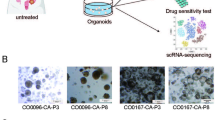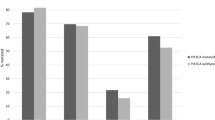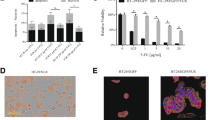Abstract
Tumor heterogeneity may give rise to differential responses to chemotherapy drugs. Therefore, unraveling tumor heterogeneity has an implication for biomarker discovery and cancer therapeutics. To test this phenomenon, we investigated the differential responses of three secondary colorectal cancer cell lines of different origins (HCT116, HT29, and SW620 cells) and four novel primary cell lines obtained from different colorectal cancer patients to 5-fluorouracil (5-FU) and oxaliplatin (L-OHP) and explored the differences in gene expression among the primary cell lines in response to exposure to cytotoxic drugs. Cells were exposed to different doses of 5-FU and L-OHP separately or in combinations of equitoxic drug or equimolar drug ratios (median effect of Chou-Talalay principle). Cell viability was assessed using MTT assay and the respective IC50 values were determined. Changes in gene expression in primary cell lines after exposure to the same drug doses were compared using real-time PCR array. The sensitivities (IC50) of different cell lines, both secondary and primary, to 5-FU and L-OHP were significantly different, whether in monotherapy or combined treatment. Primary cell lines needed higher doses to reach IC50. There were variations in gene expression among the primary cell lines of different chemosensitivities to the challenge of the same combined dose of 5-FU and L-OHP. The results confirm the heterogeneous nature of colorectal cancer cells from different patient tumors. Studies using primary cancer cells established from patient’s tumors rather than secondary cell lines will more closely reflect the actual character of the disease.

Similar content being viewed by others

References
AbuHammad S, Zihlif M (2013) Gene expression alterations in doxorubicin resistant MCF7 breast cancer cell line. Genomics 101(4):213–220
Agarwal P, Sandey M, DeInnocentes P, Bird RC (2013) Tumor suppressor gene p16/INK4A/CDKN2A-dependent regulation into and out of the cell cycle in a spontaneous canine model of breast cancer. J Cell Biochem 114(6):1355–1363
Ahmed D, Eide PW, Eilertsen IA, Danielsen SA, Eknaes M, Hektoen M, Lind GE, Lothe RA (2013) Epigenetic and genetic features of 24 colon cancer cell lines. Oncogenesis 2:e71
Altaha R, Liang X, Yu JJ, Reed E (2004) Excision repair cross complementing-group 1: gene expression and platinum resistance. Int J Mol Med 14(6):959–970
Altschuler SJ, Wu LF (2010) Cellular heterogeneity: do differences make a difference? Cell 141(4):559–563
Arul M, Roslani AC, Ng CLL, Cheah SH (2014) Culture of low passage colorectal cancer cells and demonstration of variation in selected tumour marker expression. Cytotechnology 66(3):481–491
Bijnsdorp IV, Giovannetti E, Peters GJ (2011) Analysis of drug interactions. Methods Mol Biol 731:421–434
Boyd LK, Mao X, Lu YJ (2012) The complexity of prostate cancer: genomic alterations and heterogeneity. Nat Rev Urol 9(11):652–664
Burrell RA, McGranahan N, Bartek J, Swanton C (2013) The causes and consequences of genetic heterogeneity in cancer evolution. Nature 501(7467):338–345
Chou TC, Talalay P (1984) Quantitative analysis of dose-effect relationships: the combined effects of multiple drugs or enzyme inhibitors. Adv Enz Regul 22:27–55
Christmann MA, Kaina B (2013) Transcriptional regulation of human DNA repair genes following genotoxic stress: trigger mechanisms, inducible responses and genotoxic adaptation. Nucleic Acids Res 41(18):8403–8420
Dangles-Marie V, Pocard M, Richon S, Weiswald LB, Assayag F, Saulnier P, Judde JG, Janneau JL, Auger N, Validire P, Dutrillaux B, Praz F, Bellet D, Poupon MF (2007) Establishment of human colon cancer cell lines from fresh tumors versus xenografts: comparison of success rate and cell line features. Cancer Res 67(1):398–407
De Angelis PM, Svendsrud DH, Kravik KL, Stokke T (2006) Cellular response to 5-fluorouracil (5-FU) in 5-FU-resistant colon cancer cell lines during treatment and recovery. Mol Cancer 5:20
Douillard JY, Cunningham D, Roth AD, Navarro M, James RD, Karasek P, Jandik P, Iveson T, Carmichael J, Alakl M, Gruia G, Awad L, Rougier P (2000) Irinotecan combined with fluorouracil compared with fluorouracil alone as first-line treatment for metastatic colorectal cancer: a multicentre randomised trial. Lancet 355(9209):1041–1047
Douillard JY, Sobrero A, Carnaghi C, Comella P, Diaz-Rubio E, Santoro A, Van Cutsem E (2003) Metastatic colorectal cancer: integrating irinotecan into combination and sequential chemotherapy. Ann Oncol 14(Suppl 2):ii7–i12
Dylla SJ, Beviglia L, Park IK, Chartier C, Raval J, Ngan L, Pickell K, Aguilar J, Lazetic S, Smith-Berdan S, Clarke MF, Hoey T, Lewicki J, Gurney AL (2008) Colorectal cancer stem cells are enriched in xenogeneic tumors following chemotherapy. PLoS One 3(6):e2428
Edmondson R, Broglie JJ, Adcock AF, Yang L (2014) Three-dimensional cell culture systems and their applications in drug discovery and cell-based biosensors. Assay Drug Dev Technol 12(4):207–218
Failli A, Consolini R, Legitimo A, Spisni R, Castagna M, Romanini A, Crimaldi G, Miccoli P (2009) The challenge of culturing human colorectal tumor cells: establishment of a cell culture model by the comparison of different methodological approaches. Tumori 95(3):343–347
Fischel JL, Rostagno P, Formento P, Dubreuil A, Etienne MC, Milano G (2001) Ternary combination of irinotecan, fluorouracil-folinic acid and oxaliplatin: results on human colon cancer cell lines. Br J Cancer 84(4):579–585
Fisher R, Pusztai L, Swanton C (2013) Cancer heterogeneity: implications for targeted therapeutics. Br J Cancer 108(3):479–485
Flis S, Splwinski J (2009) Inhibitory effects of 5-fluorouracil and oxaliplatin on human colorectal cancer cell survival are synergistically enhanced by sulindac sulfide. Anticancer Res 29(1):435–441
Friedlander TW, Fong L (2014) The end of the beginning: circulating tumor cells as a biomarker in castration-resistant prostate cancer. J Clin Oncol 32(11):1104–1106
Garg A, Aggarwal BB (2002) Nuclear transcription factor-kappaB as a target for cancer drug development. Leukemia 16(6):1053–1068
Geyer FC, Weigelt B, Natrajan R, Lambros MB, de Biase D, Vatcheva R, Savage K, Mackay A, Ashworth A, Reis-Filho JS (2010) Molecular analysis reveals a genetic basis for the phenotypic diversity of metaplastic breast carcinomas. J Pathol 220(5):562–573
Giacchetti S, Perpoint B, Zidani R, Le Bail N, Faggiuolo R, Focan C, Chollet P, Llory JF, Letourneau Y, Coudert B, Bertheaut-Cvitkovic F, Larregain-Fournier D, Le Rol A, Walter S, Adam R, Misset JL, Levi F (2000) Phase III multicenter randomized trial of oxaliplatin added to chronomodulated fluorouracil-leucovorin as first-line treatment of metastatic colorectal cancer. J Clin Oncol 18(1):136–147
Goodspeed A, Heiser LM, Gray JW, Costello JC (2016) Tumor-derived cell lines as molecular models of cancer pharmacogenomics. Mol Cancer Res 14(1):3–13
Gossage L, Madhusudan S (2007) Current status of excision repair cross complementing-group 1 (ERCC1) in cancer. Cancer Treat Rev 33(6):565–577
Greene BT, Hughes AD, King MR (2012) Circulating tumor cells: the substrate of personalized medicine? Front Oncol 2:69
Hato SV, de Vries IJ, Lesterhuis WJ (2012) STATing the importance of immune modulation by platinum chemotherapeutics. Oncoimmunology 1(2):234–236
Heppner GH (1984) Tumor heterogeneity. Cancer Res 44(6):2259–2265
Housman G, Byler S, Heerboth S, Lapinska K, Longacre M, Snyder N, Sarkar S (2014) Drug resistance in cancer: an overview. Cancers 6:1769–1792
Johnston PG, Kaye S (2001) Capecitabine: a novel agent for the treatment of solid tumors. Anti-Cancer Drugs 12(8):639–646
Joyce NC, Harris DL, Zhu CC (2011) Age-related gene response of human corneal endothelium to oxidative stress and DNA damage. Invest Ophthalmol Vis Sci 52(3):1641–1649
Kadoyama K, Miki I, Tamura T, Brown JB, Sakaeda T, Okuno Y (2012) Adverse event profiles of 5-fluorouracil and capecitabine: data mining of the public version of the FDA adverse event reporting system, AERS, and reproducibility of clinical observations. Int J Med Sci 9(1):33–39
Katano K, Safaei R, Samimi G, Holzer A, Rochdi M, Howell SB (2003) The copper export pump ATP7B modulates the cellular pharmacology of carboplatin in ovarian carcinoma cells. Mol Pharmacol 64(2):466–473
King RJB, Robins MW (2006) Cancer biology. Pearson Education Limited, England
Ku JL, Shin YK, Kim DW, Kim KH, Choi JS, Hong SH, Jeon YK, Kim SH, Kim HS, Park JH, Kim IJ, Park JG (2010) Establishment and characterization of 13 human colorectal carcinoma cell lines: mutations of genes and expressions of drug-sensitivity genes and cancer stem cell markers. Carcinogenesis 31(6):1003–1009
Kweekel DM, Gelderblom H, Guchelaar HJ (2005) Pharmacology of oxaliplatin and the use of pharmacogenomics to individualize therapy. Cancer Treat Rev 31(2):90–105
Lee J-Y, Yoon J-K, Kim B, Kim S, Kim MA, Lim H, Bang D, Song Y-S (2015) Tumor evolution and intratumor heterogeneity of an epithelial ovarian cancer investigated using next-generation sequencing. BMC Cancer 15(1):1–9
Lehar J, Krueger AS, Avery W, Heilbut AM, Johansen LM, Price ER, Rickles RJ, Short GF 3rd, Staunton JE, Jin X, Lee MS, Zimmermann GR, Borisy AA (2009) Synergistic drug combinations tend to improve therapeutically relevant selectivity. Nat Biotechnol 27(7):659–666
Lin CC, Lin SY, Chung JG, Lin JP, Chen GW, Kao ST (2006) Down-regulation of cyclin B1 and up-regulation of Wee1 by berberine promotes entry of leukemia cells into the G2/M-phase of the cell cycle. Anticancer Res 26(2a):1097–1104
Manoochehri M, Karbasi A, Bandehpour M, Kazemi B (2014) Down-regulation of BAX gene during carcinogenesis and acquisition of resistance to 5-FU in colorectal cancer. Pathol Oncol Res 20(2):301–307
Martin LP, Hamilton TC, Schilder RJ (2008) Platinum resistance: the role of DNA repair pathways. Clin Cancer Res 14(5):1291–1295
Marusyk A, Almendro V, Polyak K (2012) Intra-tumour heterogeneity: a looking glass for cancer? Nat Rev Cancer 12(5):323–334
Mayer LD, Harasym TO, Tardi PG, Harasym NL, Shew CR, Johnstone SA, Ramsay EC, Bally MB, Janoff AS (2006) Ratiometric dosing of anticancer drug combinations: controlling drug ratios after systemic administration regulates therapeutic activity in tumor-bearing mice. Mol Cancer Ther 5(7):1854–1863
Mhaidat NM, Bouklihacene M, Thorne RF (2014) 5-fluorouracil-induced apoptosis in colorectal cancer cells is caspase-9-dependent and mediated by activation of protein kinase C-delta. Oncol Lett 8(2):699–704
Mitra A, Mishra L, Li S (2013) Technologies for deriving primary tumor cells for use in personalized cancer therapy. Trends Biotechnol 31(6):347–354
Morata-Tarifa C, Jiménez G, García MA, Entrena JM, Griñán-Lisón C, Aguilera M, Picon-Ruiz M, Marchal JA (2016) Low adherent cancer cell subpopulations are enriched in tumorigenic and metastatic epithelial-to-mesenchymal transition-induced cancer stem-like cells. Sci Rep 6:18772
Nannizzi S, Veal GJ, Giovannetti E, Mey V, Ricciardi S, Ottley CJ, Del Tacca M, Danesi R (2010) Cellular and molecular mechanisms for the synergistic cytotoxicity elicited by oxaliplatin and pemetrexed in colon cancer cell lines. Cancer Chemother Pharmacol 66(3):547–558
Orlowski RZ, Baldwin AS Jr (2002) NF-kappaB as a therapeutic target in cancer. Trends Mol Med 8(8):385–389
Puig-Butille JA, Escamez MJ, Garcia-Garcia F, Tell-Marti G, Fabra A, Martinez-Santamaria L, Badenas C, Aguilera P, Pevida M, Dopazo J, del Rio M, Puig S (2014) Capturing the biological impact of CDKN2A and MC1R genes as an early predisposing event in melanoma and non melanoma skin cancer. Oncotarget 5(6):1439–1451
Quintana E, Shackleton M, Foster HR, Fullen DR, Sabel MS et al (2010) Phenotypic heterogeneity among tumorigenic melanoma cells from patients that is reversible and not hierarchically organized. Cancer Cell 18:510–523
Raimondi C, Nicolazzo C, Gradilone A, Giannini G, De Falco E, Chimenti I, Varriale E, Hauch S, Plappert L, Cortesi E, Gazzaniga P (2014) Circulating tumor cells: exploring intratumor heterogeneity of colorectal cancer. Cancer Biol Ther 15(5):496–503
Ray S, Langan RC, Mullinax JE, Koizumi T, Xin H-W, Wiegand GW, Anderson AJ, Stojadinovic A, Thorgeirsson S, Rudloff U, Avital I (2012) Establishment of human ultra-low passage colorectal cancer cell lines using spheroids from fresh surgical specimens suitable for in vitro and in vivo studies. J Cancer 3:196–206
Rowehl RA, Burke S, Bialkowska AB, Pettet DW III, Rowehl L, Li E, Antoniou E, Zhang Y, Bergamaschi R, Shroyer KR, Ojima I, Botchkina GI (2014) Establishment of highly tumorigenic human colorectal cancer cell line (CR4) with properties of putative cancer stem cells. PLoS One 9(6):e99091
Sharma SV, Haber DA, Settleman J (2010) Cell line-based platforms to evaluate the therapeutic efficacy of candidate anticancer agents. Nat Rev Cancer 10(4):241–253
Sherr CJ, Roberts JM (1999) CDK inhibitors: positive and negative regulators of G1-phase progression. Genes Dev 13(12):1501–1512
Smith ML, Seo YR (2002) p53 regulation of DNA excision repair pathways. Mutagenesis 17(2):149–156
Stoehlmacher J, Park DJ, Zhang W, Yang D, Groshen S, Zahedy S, Lenz HJ (2004) A multivariate analysis of genomic polymorphisms: prediction of clinical outcome to 5-FU/oxaliplatin combination chemotherapy in refractory colorectal cancer. Br J Cancer 91(2):344–354
Toloudi M, Apostolou P, Papasotiriou I (2015) Efficacy of 5-FU or oxaliplatin monotherapy over combination therapy in colorectal cancer. J Cancer Ther 6:345–355
Tomida A and T Tsuruo (2001) Drug resistance pathways as targets. In: D. J. K. Bruce C. Baguley (eds) Anticancer drug development. Academic Press
Toss A, Mu Z, Fernandez S, Cristofanilli M (2014) CTC enumeration and characterization: moving toward personalized medicine. Ann Transl Med 2(11):108
Valente MJ, Henrique R, Costa VL, Jeronimo C, Carvalho F, Bastos ML, de Pinho PG, Carvalho M (2011) A rapid and simple procedure for the establishment of human normal and cancer renal primary cell cultures from surgical specimens. PLoS One 6(5):e19337
Volkova E, Robinson BA, Willis J, Currie MJ, Dachs GU (2014) Marginal effects of glucose, insulin and insulin-like growth factor on chemotherapy response in endothelial and colorectal cancer cells. Oncol Lett 7(2):311–320
Yang K, Hitomi M, Stacey DW (2006a) Variations in cyclin D1 levels through the cell cycle determine the proliferative fate of a cell. Cell Div 1:32
Yang YA, Zhang GM, Feigenbaum L, Zhang YE (2006b) Smad3 reduces susceptibility to hepatocarcinoma by sensitizing hepatocytes to apoptosis through downregulation of Bcl-2. Cancer Cell 9(6):445–457
Acknowledgements
This research was supported in part by a University of Malaya Research University grant (no. RG534-13HTM).
Author information
Authors and Affiliations
Corresponding authors
Additional information
Editor: Tetsuji Okamoto
Electronic supplementary material
.
ESM 1
(DOCX 22 kb)
Rights and permissions
About this article
Cite this article
Arul, M., Roslani, A.C. & Cheah, S.H. Heterogeneity in cancer cells: variation in drug response in different primary and secondary colorectal cancer cell lines in vitro. In Vitro Cell.Dev.Biol.-Animal 53, 435–447 (2017). https://doi.org/10.1007/s11626-016-0126-x
Received:
Accepted:
Published:
Issue Date:
DOI: https://doi.org/10.1007/s11626-016-0126-x



